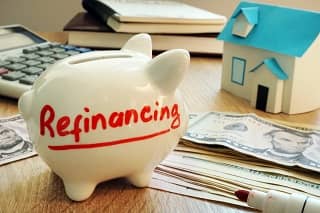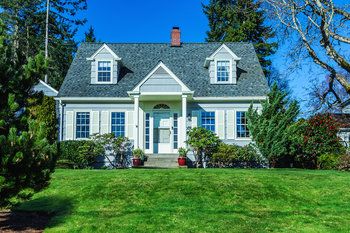If you're building your dream dwelling, chances are you'll need financing -- according to the 2000 Census housing figures, only about 20% of those having a new home built can afford to pay cash. While construction financing is very short-term and so the interest rate is less important, your permanent financing should be the best you can get. Here's what you need to know about refinancing your construction loan.
Refinancing Your Construction-to-Permanent Mortgage
The beauty of a construction-to-permanent mortgage is that it saves you the hassles of multiple loan applications, multiple trips to the title company and multiple sets of lender fees and title charges. Most people who have their residence custom-built choose this kind of mortgage financing. However, one drawback to this kind of loan is that it locks you in with your construction lender. That is, you don't know what mortgage rates you'll be offered when it's time to convert your loan to the permanent phase until the construction is complete. With construction phases taking as long as 18 months to complete, that's a lot of uncertainty. You're kind of stuck because you have probably paid your lender fees already.
However, you should not just accept your lender's offering without comparing current mortgage rates from several lenders. One-time-close mortgages can save money by consolidating some fees, but it's no savings if your permanent loan's interest is significantly higher than current mortgage rates. It's best to get some quotes on refinance rates, and then use a refinance calculator to see how long it would take for you to break even if you replace your construction-to-perm loan with a new mortgage. You may also be able to negotiate a lower rate with your construction lender if you bring in some disclosures from other lenders and indicate that you'll walk if you don't get a better deal.
Many homeowners build their custom castle when they plan on keeping the property for a very long time. The longer the hold period the more value there can be in shopping for the lowest mortgage rate you can get for your permanent loan.
Refinancing Your Straight Construction Loan
People who take out straight construction loans usually fall into a couple of categories. They may be owner-builders who plan to act as their own contractor or do the lion's share of the building themselves. Many lenders shy away from this kind of borrower because they have little way of knowing if the home will in fact be owner-occupied or if it is really a speculative home in disguise. These borrowers may have to finance their new construction as if it were an investment, generally via a straight construction loan with a local bank. If you are an owner-builder with a straight construction loan, you'll need to refinance to a permanent loan once construction is complete.
The other borrower who prefers straight construction loans doesn't want to be held captive when it's time for permanent financing. People who want to be free to shop for their permanent financing when the construction is over opt for a straight construction loan. They then look for a refinance mortgage for their permanent financing.
Shopping for Your Construction Refinance
Refinancing construction loans is a little different from refinancing a traditional mortgage. When your home nears completion, you'll want to start shopping for interest rates, collecting Good Faith Estimates, and interviewing loan officers. Take care during your construction period so that your credit does not deteriorate, which would make it harder for you to get approved for the best interest rates. For example, Fannie Mae will not accept a construction-to-perm loan if the credit documents are over 90 days old, so your lender will probably pull a credit report again just before closing. If your credit score has dropped, it will affect the price of your loan, and if severe enough, may make it unattainable.
Keep any transaction-related borrowing to a minimum, wrapping fees into the loan only when necessary. Exhausting any interest reserve account will mean making payments, and if property values drop and the finished home appraises for less than expected, you may have to come up with additional money before closing. In today's volatile market, a drop in final market value is a real danger.
Finding a builder, selecting a floor plan, picking out fixtures, and choosing materials can be exasperating. With online access to a variety of mortgage programs and rate quotes, nailing down your financing shouldn't be.
Related links :



